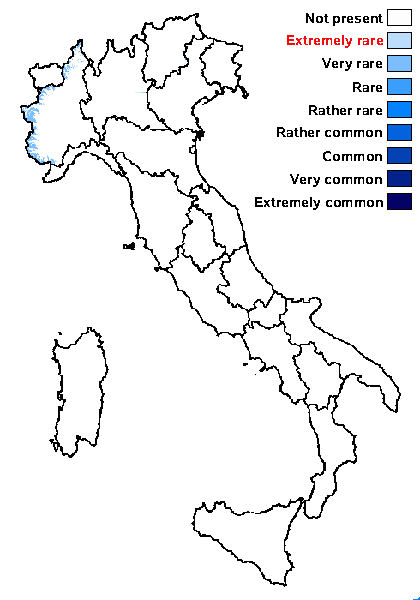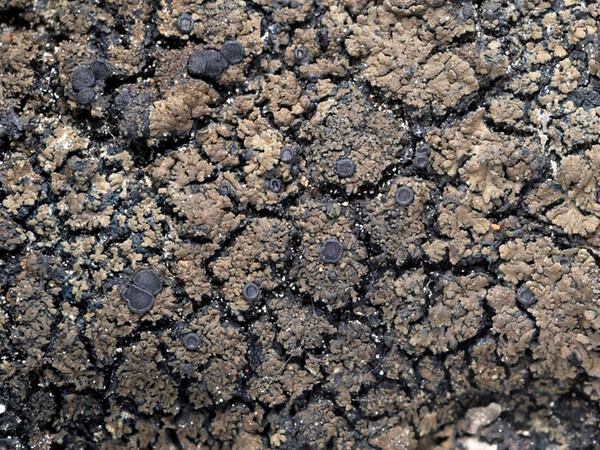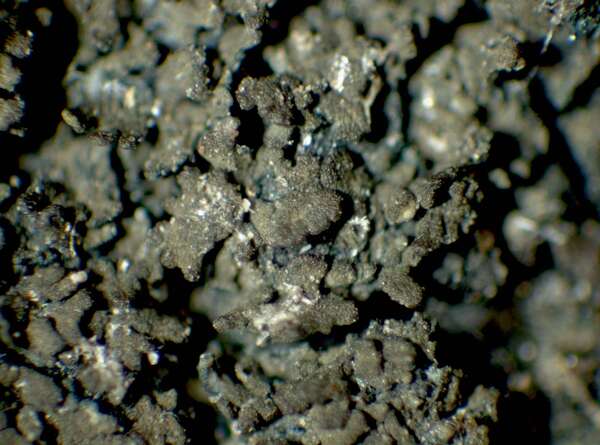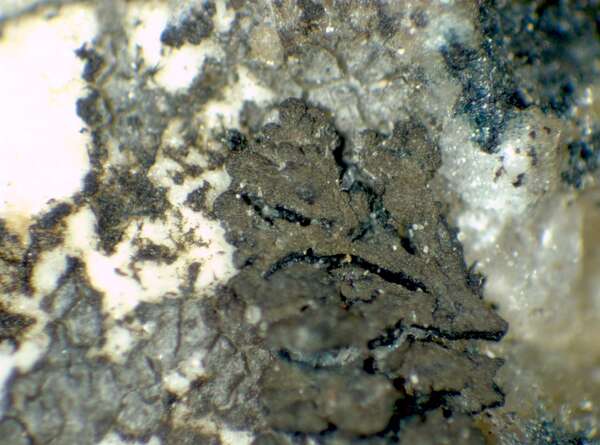Placynthium rosulans (Th. Fr.) Zahlbr.
Cat. Lich. Univ., 3: 235, 1925. Basionym: Lecothecium corallinoides subsp. rosulans Th. Fr. - Bot. Not.: 12, 1863.
Synonyms: Placynthium pannariellum (Nyl.) H. Magn. var. rosulans (Th. Fr.) Degel.
Distribution: N - Piem (TSB 34355).
Description: Thallus crustose-placodioid, dark olive-green to olive-brown, developing on a dark blue-green hypothallus, forming 0.5-3 cm wide rosettes, the central parts irregularly areolate, the areoles 0.4-1.8(-2.5) mm wide and up to 0.4 mm thick; marginal lobules flat to slightly convex, finely striate, 0.3-0.6(-1) mm long and 0.2-0.6(-1.2) mm wide, usually contiguous and radiating; prothallus absent or thin, dark blue. Upper cortex thin, olivaceous green; medulla white, of densely aggregated, robust, elongated hyphae which are periclinally arranged or fan-shaped towards the surface; lower cortex paraplectenchymatous, with abundant dark rhizohyphae. Apothecia lecideine, sessile, 0.4-0.8(-1) mm across, with a concave to finally convex, dark brown to almost black disc, and a blackish to dark bluish brown, finally often excluded proper margin. Proper exciple dark bluish green, (60-)70-80(-90) µm wide; epithecium dark grey-brown; hymenium colourless, 120-130 µm high, I+ blue; paraphyses distinctly septate, sparingly branched; hypothecium colourless or brownish. Asci 8-spored, apically thickened, with an amyloid cap. Ascospores (1-)2-3-septate, hyaline, cylindrical to narrowly ellipsoid, (10-)12-18(-20) x (4-)5-6 µm. Pycnidia immersed, with a dark blue ostiolar region. Conidia bacilliform, 5-7 x c. 1 µm. Photobiont cyanobacterial, Scytonema-like. Spot tests: all negative. Chemistry: without lichen substances. Note: a northern species found on moist siliceous rocks, e.g. in inundation zones along brooks, near or above treeline; known from a few localities in the Alps, but perhaps more widespread. The relationship with P. pannariellum still needs further study.
Growth form: Crustose
Substrata: rocks
Photobiont: cyanobacteria, filamentous (e.g. Nostoc, Scytonema)
Reproductive strategy: mainly sexual
Periodically submerged (e.g. in creeks)
Poorly known taxon in need of further study
Commonnes-rarity: (info)
Alpine belt: very rare
Subalpine belt: extremely rare
Oromediterranean belt: absent
Montane belt: absent
Submediterranean belt: absent
Padanian area: absent
Humid submediterranean belt: absent
Humid mediterranean belt: absent
Dry mediterranean belt: absent

Predictive model
Herbarium samples
Growth form: Crustose
Substrata: rocks
Photobiont: cyanobacteria, filamentous (e.g. Nostoc, Scytonema)
Reproductive strategy: mainly sexual
Periodically submerged (e.g. in creeks)
Poorly known taxon in need of further study
Commonnes-rarity: (info)
Alpine belt: very rare
Subalpine belt: extremely rare
Oromediterranean belt: absent
Montane belt: absent
Submediterranean belt: absent
Padanian area: absent
Humid submediterranean belt: absent
Humid mediterranean belt: absent
Dry mediterranean belt: absent

Predictive model
| Herbarium samples |
 INDEX FUNGORUM
INDEX FUNGORUM
 GBIF
GBIF





